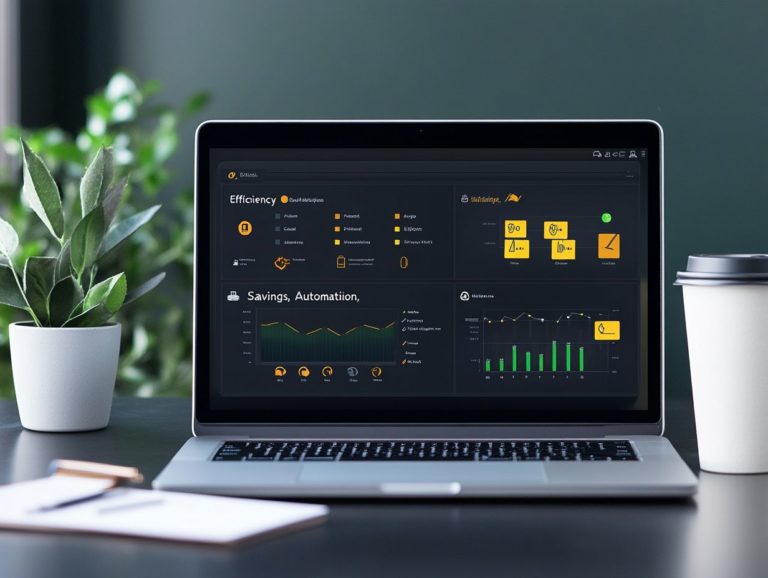How to Conduct a Cloud Cost Analysis
Cloud computing has revolutionized the way you conduct business, providing unmatched flexibility and scalability.
However, with these advantages come certain complexities, particularly when it comes to managing costs. Grasping the intricacies of cloud expenses is crucial for maximizing your investment.
This article delves into the essentials of cloud costs, examining the various types of cloud services, the factors that influence expenses, and the significance of performing a thorough cost analysis.
Uncover the steps and tools necessary to optimize your cloud spending effectively.
Elevate your cloud strategy now and unlock significant savings!
Contents
- Key Takeaways:
- Understanding Cloud Costs
- Why Conduct a Cloud Cost Analysis
- Benefits of Analyzing Cloud Costs
- Factors to Consider in a Cloud Cost Analysis
- Usage and Resource Costs
- Hidden Costs and Cost Optimization
- Steps to Conduct a Cloud Cost Analysis
- Tools for Conducting a Cloud Cost Analysis
- Frequently Asked Questions
Key Takeaways:

- Understand the different types of cloud services available before conducting a cost analysis.
- Analyzing cloud costs can lead to cost optimization and overall benefits for a company.
- Consider usage, resource costs, and hidden costs to create an effective cost optimization plan.
Understanding Cloud Costs
Understanding cloud costs is paramount if you’re looking to optimize your overall IT expenditures. As your organization embraces cloud infrastructure, gaining visibility into spending patterns and the costs tied to various services becomes essential.
By conducting a comprehensive cloud cost analysis, you can uncover effective strategies to reduce operational expenses. This approach ensures that you maximize the value derived from your cloud investments, especially when you learn how to develop a cloud cost management plan.
What is Cloud Computing?
Cloud computing is essentially the delivery of computing services over the internet, allowing you to tap into a wealth of resources such as storage, databases, and applications on-demand. This is made possible through various models like Software as a Service (SaaS), Platform as a Service (PaaS), and Infrastructure as a Service (IaaS).
This groundbreaking technology enables businesses of all sizes to scale operations efficiently while minimizing the need for extensive physical infrastructure.
With SaaS, you gain access to ready-to-use applications, freeing you from the headaches of software maintenance and updates. PaaS offers a robust environment for developers, enabling them to build, test, and deploy applications seamlessly.
Meanwhile, IaaS provides flexible, software-based representations of physical hardware, simplifying your IT management and liberating you from the constraints of hardware management.
By leveraging cloud service providers, you can enhance collaboration, foster innovation, and significantly improve your operational agility. This leads to substantial cost savings and a competitive edge in today s rapidly evolving digital landscape.
Types of Cloud Services
There are three primary types of cloud services you should be aware of: Software as a Service (SaaS), Platform as a Service (PaaS), and Infrastructure as a Service (IaaS). Each caters to different organizational needs and cloud cost models.
SaaS typically delivers software applications over the internet, allowing you to access these tools on a subscription basis no need for extensive hardware or maintenance costs cluttering your budget.
In contrast, PaaS provides a framework for developers to build, deploy, and manage applications without the hassle of worrying about the underlying infrastructure, effectively reducing your operational overhead.
On the flip side, IaaS offers virtualized computing resources online, giving you the flexibility to scale your infrastructure as your needs evolve. Understanding these models is essential for effective cloud cost analysis since each service comes with unique pricing strategies.
Choosing the right service can lead to significant cost savings and optimized resource utilization, making it a decision worth careful consideration.
Why Conduct a Cloud Cost Analysis
Conducting a cloud cost analysis is vital if you aim to gain a comprehensive understanding of your cloud spending and discover how to conduct a cloud cost audit to uncover potential savings.
This analysis also provides valuable insights into your current spending patterns while pinpointing underutilized resources, enabling you to extract maximum value from your cloud investments.
Benefits of Analyzing Cloud Costs

Analyzing cloud costs reveals cost-saving opportunities. You ll gain better visibility into spending patterns and identify areas to cut unnecessary expenses.
Understanding usage trends and resource consumption helps you find savings opportunities. These chances for cost reduction may have gone unnoticed before.
The insights you gather enable informed strategic decisions. You can allocate resources intelligently and prioritize projects that offer the highest return on investment.
Embracing this review process positions you for sustained growth in an ever-evolving digital landscape.
Factors to Consider in a Cloud Cost Analysis
Consider various factors in your cloud cost analysis. This includes usage patterns, resource costs, and hidden expenses that can impact your spending. For a deeper understanding, learn how to use analytics for cloud cost management.
Grasping these elements is key for effective cloud cost optimization and ensuring responsible financial decisions regarding cloud services.
Usage and Resource Costs
Usage and resource costs are critical to your cloud spending. They encompass expenses tied to computing, storage, and additional fees from services like Amazon EC2 and EBS.
Understanding how these costs accumulate over time lets you optimize your cloud strategies effectively. For example, fluctuating workloads can significantly impact computing costs.
Poor management of storage can lead to surprise expenses. The choices you make regarding services and configurations are crucial; every decision can either enhance efficiency or inflate costs.
By monitoring usage patterns and aligning resource allocation, you can manage expenses effectively and harness cloud capabilities to drive innovation without straining finances.
Hidden Costs and Cost Optimization
Hidden costs in your cloud spending can have a substantial impact on your overall expenses. To mitigate this, learn how to prepare for cloud cost changes by conducting a comprehensive analysis of your cloud billing data to uncover these additional costs and implement effective optimization strategies.
These hidden costs typically emerge from various sources, including:
- Unused resources
- Inefficient usage patterns
- Soaring data transfer fees
By leveraging cloud billing data, you can accurately identify financial pitfalls. Analyze consumption trends and address discrepancies to improve budgeting.
Using cloud cost management tools allows you to visualize your expenses and track usage in real-time. Understanding these intricacies aids in uncovering hidden costs and taking actionable steps toward optimizing your cloud budget.
Steps to Conduct a Cloud Cost Analysis
Ready to take control of your cloud costs? Follow these essential steps for a successful analysis!
Begin by leveraging advanced cloud management tools to thoroughly analyze cost metrics and historical data. This process will guide you in crafting a comprehensive cost optimization plan tailored to your organization s unique needs.
Identifying Cloud Services and Usage

Identifying cloud services and their associated usage is your first step in conducting a cloud cost analysis. This process enables you to evaluate how resources are used and optimize expenditures based on AWS (Amazon Web Services) SKUs and other relevant service metrics.
This critical analysis not only illuminates your current spending habits but also uncovers patterns that can forecast future needs and costs. By grasping how different services are utilized, you can pinpoint underutilized resources that might otherwise lead to unnecessary expenses if left unchecked.
Tracking specific metrics like CPU utilization and data transfer rates reveals areas ripe for improvement. This allows for more effective budgeting and strategic planning in your cloud deployments. Essentially, this proactive approach paves the way for significant long-term savings while maximizing the value you derive from your cloud investments.
Analyzing Cost Metrics
Analyzing cost metrics is essential for your cloud cost analysis. It enables you to monitor your cloud spending and make informed financial decisions that significantly influence overall cloud efficiency. For more insights, check out how to evaluate cloud pricing models.
By systematically evaluating various financial indicators such as usage rates, how resources are used, and historical spending trends you can gain a clearer understanding of your cloud expenses.
Key metrics to consider include:
- Cost per user
- Compute resource utilization
- Storage costs
Each of these metrics plays a crucial role in revealing how effectively your resources are allocated. By tracking these figures over time, you’ll be able to pinpoint inefficiencies or unnecessary expenditures.
Leveraging the insights gained from these analyses allows you to optimize your cloud strategies and adjust your budgets accordingly, promoting more cost-effective operations.
Creating a Cost Optimization Plan
Creating a cost optimization plan is crucial to your success. This plan enables you to devise strategies that effectively manage cloud spending while leveraging cloud management tools to enhance operational efficiency.
By pinpointing potential savings, you can significantly trim unnecessary expenses and maximize the value you extract from your cloud investments. Your plan should encompass various components, such as:
- How resources are used analysis
- Rightsizing instances
- Implementing budgeting controls
Utilizing tools like cloud monitoring and automation will assist you in tracking expenditures in real-time. Regularly reviewing billing reports and employing tagging strategies for enhanced visibility will enable stakeholders to make informed decisions that elevate cost efficiency.
Ultimately, adopting a comprehensive approach cuts down on waste and enables your organization to operate within its financial boundaries while maintaining high performance.
Tools for Conducting a Cloud Cost Analysis
Utilizing the right tools for conducting a cloud cost analysis can profoundly elevate your process. It enables you to streamline the evaluation of cloud billing data and ensures you’re ready with how to prepare for cloud cost audits.
By leveraging automated AWS cloud solutions and advanced cloud cost intelligence, you can enhance efficiency and gain deeper insights into your cloud expenditures.
Popular Cloud Cost Analysis Tools
Several renowned cloud cost analysis tools, including CloudZero and nOps, help you easily track your spending and save money.
These tools allow you to track usage patterns, pinpoint areas of overspending, and accurately forecast future costs. By integrating advanced machine learning algorithms, they deliver predictive analytics that enable you to allocate resources with remarkable efficiency.
Customizable dashboards provide you with the ability to visualize spending trends in real-time, making informed strategic planning a seamless process.
A comparative analysis shows that while CloudZero excels in offering detailed cost breakdowns and tagging capabilities, nOps distinguishes itself with its automation features, significantly reducing the need for manual oversight.
These functionalities equip you with the essential knowledge to optimize cloud expenditure and foster accountability across your organization.
Frequently Asked Questions

1. What is a cloud cost analysis?
A cloud cost analysis evaluates the costs of using cloud services. It helps businesses find budget-friendly solutions.
2. Why should I conduct a cloud cost analysis?
This analysis clarifies cloud spending and uncovers cost-saving chances. It also helps allocate resources wisely and prevents unnecessary overspending.
3. How do I conduct a cloud cost analysis?
Start by collecting data on your current cloud usage and costs. This includes details about services, users, and recurring fees, which will help you learn how to forecast cloud expenses.
Next, compare prices from different providers to find the best value for your needs.
4. What factors should I consider?
Consider the services required, support levels, storage, and processing power. Also, look at any extra features that could affect costs.
5. How often should I conduct one?
Conduct a cloud cost analysis at least once a year, and consider how to measure cloud cost performance whenever your business needs change significantly.
6. Are there tools to help?
Yes! Many tools can simplify this process. They gather data on your usage and compare costs across providers.
Some popular options include CloudCheckr, Cloudyn, and CloudHealth. Discover which tool fits your business best!






